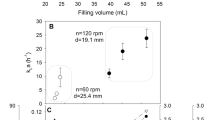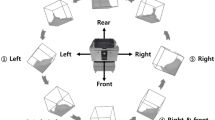Abstract
Large scale production of monoclonal antibodies has been accomplished using bioreactors with different length to diameter ratios, and diverse impeller and sparger designs. The differences in these physical attributes often result in dissimilar mass transfer, mechanical stresses due to turbulence and mixing inside the bioreactor that may lead to disparities in cell growth and antibody production. A rational analysis of impeller design parameters on cell growth, protein expression levels and subsequent antibody production is needed to understand such differences. The purpose of this study was to examine the impact of Rushton turbine and marine impeller designs on Chinese hamster ovary (CHO) cell growth and metabolism, and antibody production and quality. Experiments to evaluate mass transfer and mixing characteristics were conducted to determine if the nutrient requirements of the culture would be met. The analysis of mixing times indicated significant differences between marine and Rushton turbine impellers at the same power input per unit volume of liquid (P/V). However, no significant differences were observed between the two impellers at constant P/V with respect to oxygen and carbon dioxide mass transfer properties. Experiments were conducted with CHO cells to determine the impact of different flow patterns arising from the use of different impellers on cell growth, metabolism and antibody production. The analysis of cell culture data did not indicate any significant differences in any of the measured or calculated variables between marine and Rushton turbine impellers. More importantly, this study was able to demonstrate that the quality of the antibody was not altered with a change in the impeller geometry.





Similar content being viewed by others
Abbreviations
- CHO:
-
Chinese hamster ovary
- P :
-
Power (W)
- V :
-
Volume (L)
- DHFR:
-
Dihydrofolate reductase
- Re :
-
Reynolds number (dimensionless)
- IgG:
-
Immunoglobulin
- HPLC:
-
High-performance liquid chromatography
- H :
-
Liquid height in reactor (m)
- T :
-
Reactor diameter (m)
- DO:
-
Dissolved oxygen (%)
- ρ :
-
Density (kg/m3)
- P 0 :
-
Power number (marine 0.4, Rushton 5)
- N :
-
Agitation rate (rev/s)
- D :
-
Impeller diameter (m)
- n :
-
Number of impellers
- μ :
-
Viscosity (mPa s)
- θ m :
-
Mixing time (s)
- ε T :
-
Mean specific energy dissipation rate (W/kg)
- k L a O :
-
Mass transfer coefficient for oxygen in culture medium (h−1)
- k L a sO :
-
Surface mass transfer coefficient for oxygen (h−1)
- vvh:
-
Volume of gas per volume of liquid per hour
- slpm:
-
Standard liters per minute
- ppm:
-
Parts per million
- C*:
-
Saturation concentration of oxygen (% dissolved oxygen)
- C L :
-
Concentration of oxygen gas in bulk liquid (% dissolved oxygen)
- OUR:
-
Oxygen utilization rate (% dissolved oxygen/h)
- C oxygen :
-
Concentration of oxygen (% dissolved oxygen)
- C T :
-
Total inorganic carbon
- k L a C :
-
Mass transfer coefficient for carbon dioxide (h−1)
- k corr :
-
Correction factor (dimensionless)
- ANOVA:
-
Analysis of variance
- X :
-
Total cell concentration (cells mL−1)
- X V :
-
Viable cell concentration (cells mL−1)
- μ :
-
Specific growth rate of cells (day−1)
- μ max :
-
Maximum specific growth rate of cells (day−1)
- q P :
-
Specific product formation rate (pg/cell/day)
- α :
-
Growth associated product rate constant
- β :
-
Non-growth associated product rate constant
- q Ab :
-
Specific rate of antibody production (pg/cell/day)
- q L :
-
Specific rate of lactate production (pg/cell/day)
- q N :
-
Specific rate of ammonia production (pg/cell/day)
- CFD:
-
Computational fluid dynamics
References
Mirro R, Kevin V (2009) Which impeller is right for your cell-line? vol 7. BioProcess International, USA
Schroder M, Matischak K, Friedl P (2004) Serum- and protein-free media formulations for the Chinese hamster ovary cell line DUKXB11. J Biotechnol 108(3):279–292
Urlaub G, Chasin LA (1980) Isolation of Chinese hamster cell mutants deficient in dihydrofolate reductase activity. Proc Natl Acad Sci USA 77(7):4216–4220
Eagle H (1955) Nutrition needs of mammalian cells in tissue culture. Science 122(3168):501–514
Barnes D, Sato G (1980) Methods for growth of cultured cells in serum-free medium. Anal Biochem 102(2):255–270
Bettger WJ, Ham RG (1982) Advances in nutritional research. Plenum Press, New York
Barnes D (1985) Nutritional and hormonal requirements of mammalian cells in culture. World Rev Nutr Diet 45:167–197
Blanch HW, Clark DS (1997) Biochemical engineering. Marcel Dekker, New York
Bibila TA, Ranucci CS, Glazomitsky K, Buckland BC, Aunins JG (1994) Monoclonal-antibody process-development using medium concentrates. Biotechnol Prog 10(1):87–96
Hu WS, Aunins JG (1997) Large-scale mammalian cell culture. Curr Opin Biotechnol 8(2):148–153
Sandadi S, Ensari S, Kearns B (2005) Heuristic optimization of antibody production by Chinese hamster ovary cells. Biotechnol Prog 21(5):1537–1542
Meier S (2005) Scaleup/scaledown and mixing in industrial cell culture reactors. Biochemical engineering XIV, Harrison Hot Springs, BC
Oh SKW, Nienow AW, Alrubeai M, Emery AN (1989) The effects of agitation intensity with and without continuous sparging on the growth and antibody-production of hybridoma cells. J Biotechnol 12(1):45–61
Oh SKW, Nienow AW, Alrubeai M, Emery AN (1992) Further-studies of the culture of mouse hybridomas in an agitated bioreactor with and without continuous sparging. J Biotechnol 22(3):245–270
Moran EB, McGowan ST, McGuire JM, Frankland JE, Oyebade IA, Waller W, Archer LC, Morris LO, Pandya J, Nathan SR, Smith L, Cadette ML, Michalowski JT (2000) A systematic approach to the validation of process control parameters for monoclonal antibody production in fed-batch culture of a murine myeloma. Biotechnol Bioeng 69(3):242–255
Sandadi S, Ensari S, Kearns B (2006) Application of fractional factorial designs to screen active factors for antibody production by Chinese hamster ovary cells. Biotechnol Prog 22(2):595–600
Varley J, Birch J (1999) Reactor design for large scale suspension animal cell culture. Cytotechnology 29(3):177–205
Mardikar SH, Niranjan K (2000) Observations on the shear damage to different animal cells in a concentric cylinder viscometer. Biotechnol Bioeng 68(6):697–704
Mollet M, Ma NN, Zhao Y, Brodkey R, Taticek R, Chalmers JJ (2004) Bioprocess equipment: characterization of energy dissipation rate and its potential to damage cells. Biotechnol Prog 20(5):1437–1448
Meier SJ, Hatton TA, Wang DIC (1999) Cell death from bursting bubbles: role of cell attachment to rising bubbles in sparged reactors. Biotechnol Bioeng 62(4):468–478
Murhammer DW, Goochee CF (1990) Sparged animal-cell bioreactors—mechanism of cell-damage and Pluronic F-68 protection. Biotechnol Prog 6(5):391–397
Mollet M, Godoy-Silva R, Berdugo C, Chalmers JJ (2007) Acute hydrodynamic forces and apoptosis: a complex question. Biotechnol Bioeng 98(4):772–788
Nienow AW (2006) Reactor engineering in large scale animal cell culture. Cytotechnology 50(1–3):9–33
Junker BH, Hunt G, Burgess B, Aunins J, Buckland BC (1994) Modified microbial fermenter performance in animal-cell culture and its implications for flexible fermenter design. Bioprocess Eng 11(2):57–63
Nienow A (2008) Mixing studies with elephant ear impellers: are they low shear agitators? AIChE Annual Meeting, Philadelphia
Nienow AW, Langheinrich C, Stevenson NC, Emery AN, Clayton TM, Slater NKH (1996) Homogenisation and oxygen transfer rates in large agitated and sparged animal cell bioreactors: some implications for growth and production. Cytotechnology 22(1–3):87–94
Bailey JE, Ollis DF (1986) Biochemical engineering fundamentals, 2nd edn. McGraw-Hill, New York
Mostafa SS, Gu XJ (2003) Strategies for improved dCO(2) removal in large-scale fed-batch cultures. Biotechnol Prog 19(1):45–51
Aunins JG, Henzler H-J (1993) Aeration in cell culture bioreactors. In: Stephanopoulos G (ed) Biotechnology: a multi-volume comprehensive treatise. VCH Verlag, Weinheim
Wong DCF, Wong KTK, Goh LT, Heng CK, Yap MGS (2005) Impact of dynamic online fed-batch strategies on metabolism, productivity and N-glycosylation quality in CHO cell cultures. Biotechnol Bioeng 89(2):164–177
Nam JH, Zhang F, Ermonval M, Linhardt RJ, Sharfstein ST (2008) The effects of culture conditions on the glycosylation of secreted human placental alkaline phosphatase produced in Chinese hamster ovary cells. Biotechnol Bioeng 100(6):1178–1192
Goochee CF, Monica T (1990) Environmental-effects on protein glycosylation. BioTechnology 8(5):421–427
Nienow AW (1997) On impeller circulation and mixing effectiveness in the turbulent flow regime. Chem Eng Sci 52(15):2557–2565
Gogate PR, Beenackers AA, Pandit AB (2000) Multiple-impeller systems with a special emphasis on bioreactors: a critical review. Biochem Eng J 6(2):109–144
Hari-Prjitno D et al (1998) Gas–liquid mixing studies with multiple up- and down-pumping hydrofoil impellers: power characteristics and mixing time can. J Chem E 76:1056–1068
Nienow A (1996) Gas liquid mixing studies: a comparison of Rushton turbines with some modern impellers. Chem Eng Res Des Trans I Chem E Part A 74:417–423
Xia JY, Wang YH, Zhang SL, Chen N, Yin P, Zhuang YP, Chu J (2009) Fluid dynamics investigation of variant impeller combinations by simulation and fermentation experiment. Biochem Eng J 43(3):252–260
Bowers JS (2008) Sparger and surface gas transfer for cell culture bioreactors. AIChE Annual Meeting, Philadelphia
Ozturk SS, Riley MR, Palsson BO (1992) Effects of ammonia and lactate on hybridoma growth, metabolism, and antibody-production. Biotechnol Bioeng 39(4):418–431
Ozturk SS, Palsson BO (1990) Effects of ammonia and lactate on cell-growth, metabolism and monoclonal-antibody production. Abstracts of Papers of the American Chemical Society 200: 6-Biot
Patel SD, Papoutsakis ET, Winter JN, Miller WM (2000) The lactate issue revisited: novel feeding protocols to examine inhibition of cell proliferation and glucose metabolism in hematopoietic cell cultures. Biotechnol Prog 16(5):885–892
Sandadi S (2009) Ph.D. Dissertation. Rutgers University, Piscataway
Author information
Authors and Affiliations
Corresponding author
Rights and permissions
About this article
Cite this article
Sandadi, S., Pedersen, H., Bowers, J.S. et al. A comprehensive comparison of mixing, mass transfer, Chinese hamster ovary cell growth, and antibody production using Rushton turbine and marine impellers. Bioprocess Biosyst Eng 34, 819–832 (2011). https://doi.org/10.1007/s00449-011-0532-0
Received:
Accepted:
Published:
Issue Date:
DOI: https://doi.org/10.1007/s00449-011-0532-0




